Taiwanese Oil Rice, a tasty sticky rice treat that's lost in translation
comforting youfan is not just for baby boy joy 👶🏻👶🏻
Hello everyone!
Last year when I started playing with microwaving sticky rice, Vivienne asked if the technique could be applied to yóufàn (油飯). My Mandarin Chinese is rusty but I did recognize the words to mean “oil rice”.
Many Asian dishes have funny English translations and you have to dive deeper to understand their meaning.
said oil rice was delicious and she had been eyeing a particular recipe from Made in Taiwan, the award-winning book by and Ivy Chan.I put Vivienne’s question on my “to research” list. A few weeks ago, I shared the Microwave Sticky Rice Master Recipe andVivienne jumped on it. She reported that it worked beautifully for oil rice.
The sticky rice dish must have meant a lot to her. Such adoration got me to pull Clarissa and Ivy’s book from my shelf to make their yóufàn recipe.
The instructions required a long soak and traditional steaming for the sticky rice. Not wanting the mess, I applied my shortcut microwave-steaming method. I reduced the soaking and cooking to a 30 to 40-minute deal.
That’s how I was able to make the rice for Rory and me for lunch on a busy weekday. (I got the mushrooms soaking the night before!) It was very good.
What’s up with the name, “yóufàn”?
Clarissa explains that oil rice is lightly coated with oil for a delicate sheen, not an oily taste. Additionally, yóufàn is traditionally a dish shared with family and friends to celebrate the birth of a boy. The rice is presented with a braised chicken leg and two boiled eggs dyed to a lucky, festive red. Note the chicken and egg connection. 🐣 Oil rice is shared one month after the child’s birth.
My feisty self argues that girls are just as good as boys. We are equally worthy of sticky rice, a chicken leg, and lucky red eggs!
Luckily, the Taiwanese eat oil rice because it’s comforting, tasty food. It’s not just symbolic food for spreading baby boy joy.
How ‘made in Taiwan’ do you have to cook?
As mentioned in the sticky rice 101 dispatch, dishes featuring the sweet, glutinous rice grains are fun pleasure foods. I wanted some of that pleasure so I set aside my fight for sticky rice gender equality and made the recipe, with some tweaks so that it fit into my situation. (You do the same with my recipes, don’t you?!)
The result was salty, sweet, rich and umami filled. Taiwanese food leans toward sweet finishes, so I was skeptical of the sugar involved. But, I used the amount prescribed in Made in Taiwan, combining it with Taiwan-made soy sauce, black vinegar, and rice wine. The combination of cuisine-specific ingredients turned out great, with no cloying finish as I sometimes experienced in Taiwan.
Don’t have Taiwanese ingredients? No problem.
You can make fine risotto without using Carnaroli rice and you can make oil rice with substitutes too. Clarissa and Ivy included some in their recipe and I’ve added some more.
Regarding soy sauce, know that Taiwanese soy sauce typically contains sugar so it tastes relatively sweet compared to most soy sauces made in Hong Kong, China, Japan, and Korea.
Kimlan is a leading producer of soy sauce in Taiwan. Viet cooks adore Kimlan for its sweetness and light flavor. I like it ok but prefer sugarless soy sauce so I can add sweeteners to my own taste. That said, I did try the above multi-grain, gluten-free soy sauce by Kimlan, which tasted alright.
If you don’t have Taiwan-made soy sauce, use an extra 1/8 to 1/4 teaspoon sugar in the seasoning sauce to make up the difference.
As for the rice wine, sake is a fine substitute, which Clarissa and Ivy offer up in the original recipe.
Taiwanese black vinegar has an uncanny resemblance to Worcestershire sauce. Because you only need a little, there’s no reason to go searching for it if you’ve already got Lea & Perrins.
When you mix in the sticky rice . . .
. . . it is sticky and clumpy. It resists your spatula’s advances.
I veered off Clarissa and Ivy’s recipe on several points and this was one of them. Cook the meat and vegetables in a big pan and then mix the rice in that pan too. Less dishwashing! The trick is to methodically combine the rice with the other ingredients.
Sticky rice breaks up easily with a bit of oil so at this stage of making the rice, I better understood the name, “Oil Rice” — maybe it’s the oil that helps the sticky rice grains separate and also convey the flavors of the seasoning?!
Whatever the reason for the oil rice’s quirky name, when you make it, you must go at the mixing with a two-handed approach. Be aggressive and also patient. Break apart the rice, stir, and fold. Eventually the grains will turn chestnut brown from the seasonings and you’ll be done and ready to eat! 😌
What to serve with the rice
The rice has plenty of flavor so keep the side dishes simple. I made a salad of lettuce and radicchio dressed with lemon juice, salt and pepper, a touch of agave syrup, and neutral oil.
Bonus pointers
Can you halve the recipe? Many of us have two-person households or are cooking only for one. With the microwave sticky rice trick, you can totally make a half batch of this rice! Go for it. That said, make a full batch because leftovers are nice for future meals.
Can you make this vegan? Of course. See the recipe endnote below!
More tips for your oil rice adventure:
Dried Shiitake Mushroom Guide (how to buy, soak, and prep)
Alright, you have all my notes on this recipe. Below you’ll find the recipes for oil rice recipe plus a little sauce. Use the PDF to make cooking a little easier, if you like!
Thank you Vivienne for leading me to this gem.
P.S. If there are typos or clarification needed, ping me or post a comment!
RECIPE
Oil Rice | Taiwanese Sticky Rice, Pork and Veggies
The original recipe features pork but you can make this with chicken. Or, see the Notes for a vegan option. I tweaked a few minor things to organize the recipe to a flow that works well in my kitchen. The ingredient quantities and much more remain true to this delicious recipe from Clarissa Wei and Ivy Chan’s book, Made in Taiwan (2023, Simon Element).
Oh, there’s a little sauce called Haishan Sauce that’s optional. The flavorful rice does not need it. However, if you want the Full Monty experience, make the sauce. It is an interesting melding of cultures. Keep scrolling for the recipe!
Serves 4
Ingredients
400g | 2 cups raw long-grain sticky “sweet” rice
25g | 8 dried shiitake mushrooms, rehydrated overnight in water
1 tablespoon small dried shrimp
3 garlic cloves, minced
1 small can (150g) sliced bamboo shoots, drained
120g | 4 ounces carrot
225g | 8 ounces pork tenderloin or boneless chicken
60ml | ¼ cup plus 1 1/2 tablespoons soy sauce
1 tablespoon granulated sugar
2 teaspoons Taiwanese rice wine (Michiu) or sake
1 teaspoon Taiwanese black vinegar or Worcestershire sauce
60ml | 1/4 cup lard or neutral oil
120 g | 4 ounces thinly sliced shallot
Fresh cilantro sprigs (for garnish, optional)
60ml | 1/4 cup Haishan Sauce (optional, recipe follows)
Instructions
Cook the rice: Microwave-steam the sticky rice according to this method or use your favorite method. Fluff and cover the rice to keep warm.
Prep the mushroom, shrimp, and garlic: Set aside 1/4 cup of the mushroom soaking liquid (use the rest for something else or discard). Thinly slice the mushroom caps and if chewable, the stems too. Put the mushroom in a small bowl.
Soak the dried shrimp in hot water for 10 minutes then drain. Chop if wider than ¾ inch, then add to the mushroom bowl. Add the garlic, too.
Cut the carrot and bamboo: If the bamboo shoots smell overly strong, soak in just-boiled water for 5 to 10 minutes, drain, and pat well. Cut into matchstick-size pieces and put into a bowl. Cut the carrots to match the bamboo shoot and keep them in the same bowl.
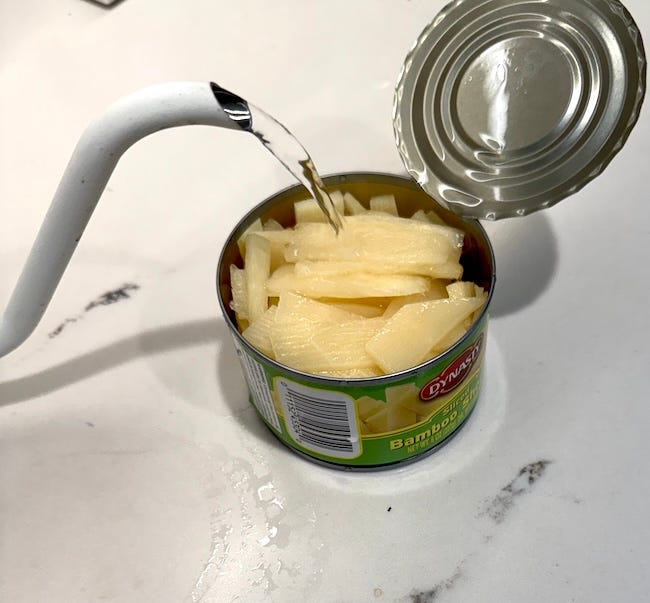
Marinate the meat: Freeze the pork (or chicken) for 15 to 20 minutes, slice thinly, then cut crosswise into fat matchsticks (a little bigger than the bamboo shoot and carrot). Put in a bowl and season with 1 1/2 tablespoons soy sauce. Let marinate 15 minutes.
Make the seasoning sauce: In a small bowl, stir together the remaining 1/4 cup soy sauce with the sugar, rice wine, black vinegar, and reserved 1/4 cup shiitake soaking liquid. Set near the stove with the remaining rice ingredients.
Cook the raw stuff: Set a large wok or non-stick deep skillet over medium, and when hot, add the lard. Swirl to cover well, then add the shallot, stirring, until soft, about 1 minute. Be careful to avoid burning the shallot. Toss in the shiitake, shrimp, and garlic, then cook until aromatic, about 30 seconds. Add the marinated meat and cook until the edges are opaque, about 1 minute. Toss in the bamboo shoot and carrot, stir to combine, then add the seasoning sauce. Cook, stirring, until the carrot slightly softens, 2 to 3 minutes. Turn off the heat and slide the pan to a cool burner.
Assemble and serve: Uncover the sticky rice, use a spatula to break it into big chunks then add to the pan. Use the spatula and the tool you just cooked with to mix the rice in. Be aggressive because the rice will initially resist breaking up into smaller clumps. Be patient and aim for the rice to become coated with the dark sauce and for the ingredients to become well distributed. When satisfied, transfer to a serving plate (or shallow bowl) and garnish with the cilantro. Serve with (or without) the Haishan Sauce.
NOTES
Go tofu! Instead of pork or chicken, use super-firm tofu or baked tofu (dougan). Slice it as matchsticks or crumble the tofu. Season as usual with the soy sauce.
How to veganize it? Use tofu and omit the dried shrimp. You’ll have plenty of umami in the rice!
Haishan Sauce | Sea Mountain Sauce
A street vendor’s favorite, this sauce is often drizzled onto fried oyster omelets. The “Sea Mountain” notion is because the sauce supposedly goes with anything from the sea to the mountains. Clarissa writes that the sauce may have started out as local take on Cantonese hoisin sauce but evolved into something distinctively Taiwanese — a bit of East and Southeast Asia all on one island. The recipe below has been reformatted from Clarissa Wei and Ivy Chan’s book, Made in Taiwan (2023, Simon Element).
Makes 1 cup
Ingredients
60ml | 1/4 cup ketchup
1 tablespoon coarse raw sugar, such as demerara
2 teaspoons white (shiro) miso
1 teaspoon chili garlic sauce or sambal oelek
240ml | 1 cup water
1 tablespoon glutinous rice flour or cornstarch diluted in 2 tablespoons water
Instructions
In a small (1-quart) saucepan, combine the ketchup, sugar, miso, chili sauce, and water. Heat over low, stirring to incorporate the miso and dissolve the sugar. Bring to boil over medium high, then lower the heat to brisk simmer.
Stir the rice (or cornstarch) slurry well then pour into the sauce. Once the sauce thickens, 30 seconds, turn off the heat. Set aside to cool to room temperature to thicken before using. Keep refrigerated for up to 2 weeks.


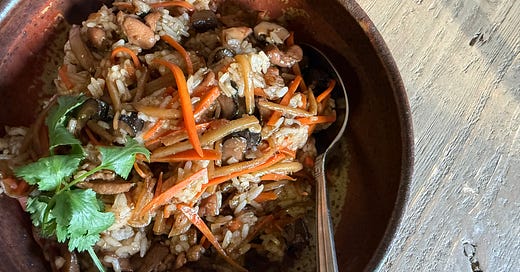



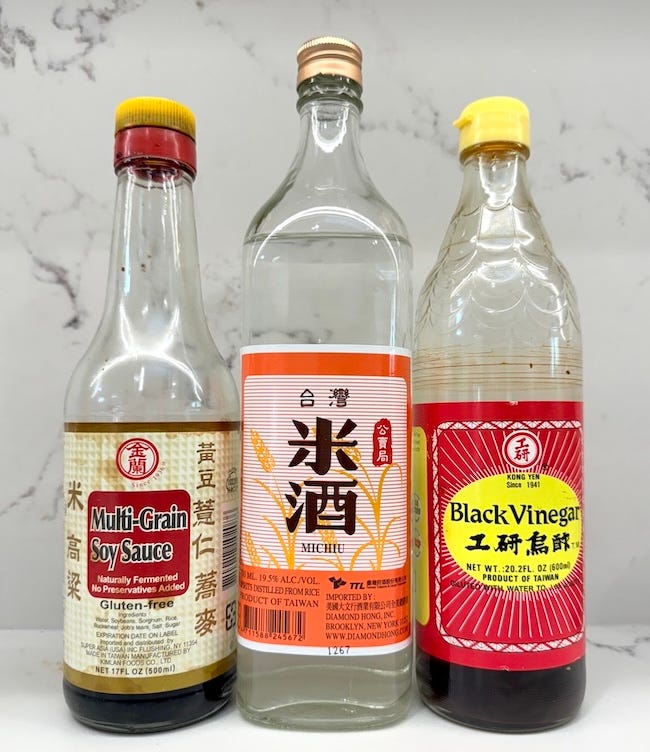
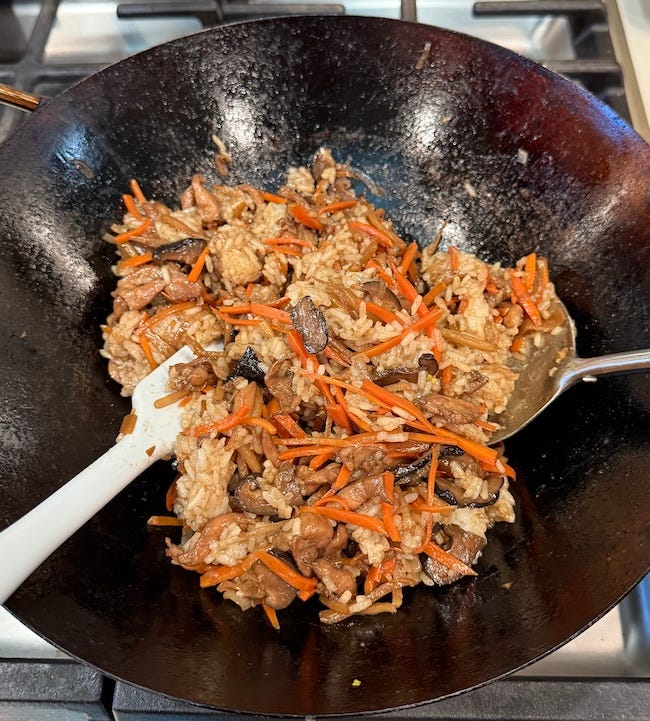
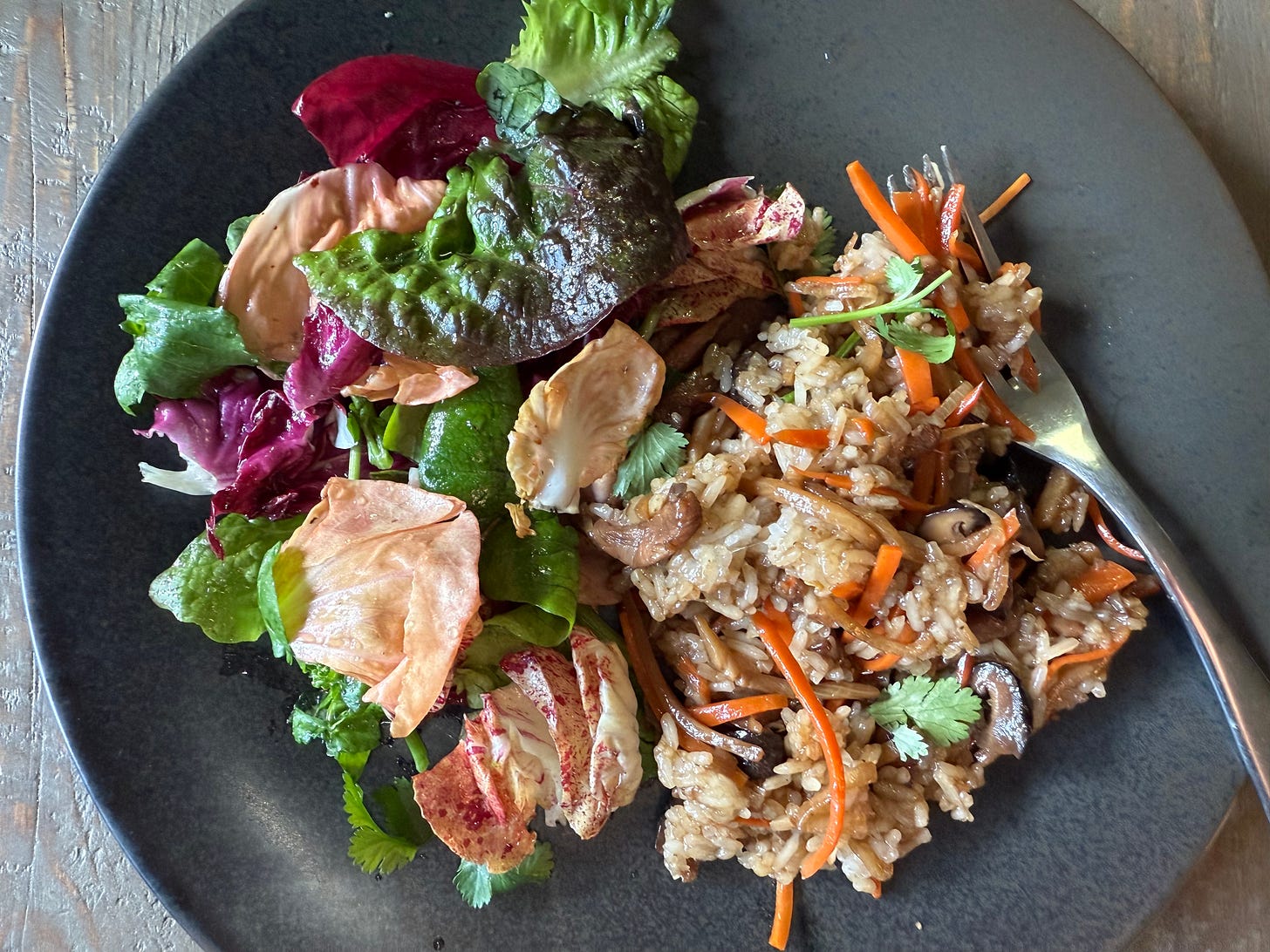


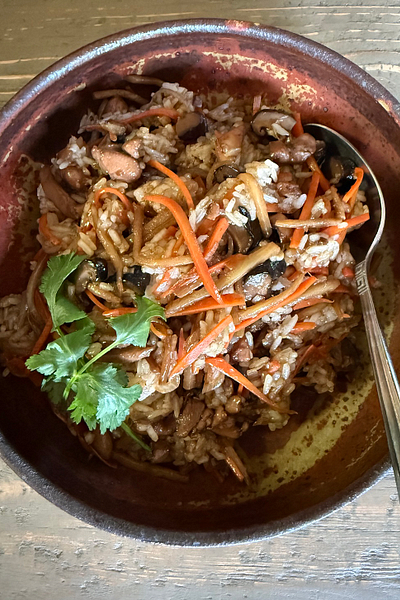
I’m so excited you tried this!
Before reading Clarissa’s book, I had not known the significance of this dish with the birth of a boy. We had it for special occasions, such as instead of bread stuffing at Thanksgiving, or when guests were over for dinner. My dad and paternal grandfather would agree with you that girls are just as important as boys.
Interesting and I will definitely make this or a version of this. (I'm not sure I can source the bamboo shoots.)
One question: I really dislike ketchup and won't be buying a bottle just to make a sauce. So I'm thinking of using tomato purée, maybe with something added (maybe a drop of lemon juice and a whiff of cinnamon?). Any suggestions for that?